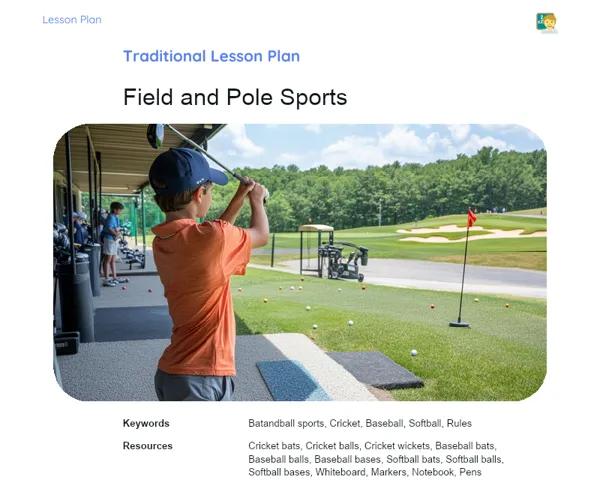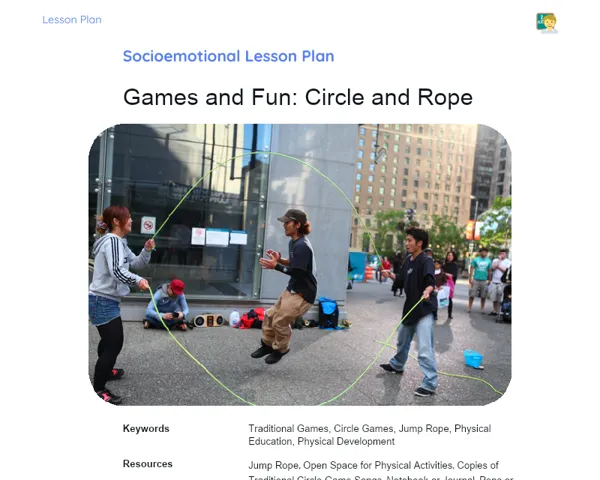Lesson Plan | Socioemotional Learning | Track and Field: Introduction
| Keywords | Track and Field, Running, Race Walking, Throwing, Jumping, Rules, Effects on the Human Body, Socio-emotional Development, Self-awareness, Self-control, Responsible Decision-Making, Social Skills, Social Awareness, Mindfulness, RULER, Physical Education, 6th Grade, Track and Field Circuit |
| Resources | Cones, Weights, Javelins, Discus, Hammer, Vaulting Pole, Space for 50-Meter Run, Whistle, Notebooks, Pens, Track and Field Competition Videos |
| Codes | - |
| Grade | 6th grade |
| Discipline | Physical Education |
Objective
Duration: (10 - 15 minutes)
The aim of this section is to familiarize students with track and field, laying a strong groundwork of knowledge about various events and their associated rules. It also seeks to foster students' socio-emotional growth by encouraging them to acknowledge and comprehend the emotions linked to sports participation, thus aiding in better self-control and decision-making.
Objective Utama
1. Identify the key events in track and field, including running, race walking, throwing, and jumping.
2. Grasp the fundamental rules of track and field events and their effects on the human body.
3. Cultivate socio-emotional skills by recognizing, understanding, and managing emotions during track and field practices.
Introduction
Duration: (15 - 20 minutes)
Emotional Warmup Activity
Mindfulness for Focus and Concentration
The Mindfulness activity encourages students to concentrate fully on the present moment, aiding them in focusing on the here and now. This can be done through a series of deep, intentional breaths while paying attention to body sensations. This practice enhances concentration and prepares students emotionally for the lesson.
1. Step 1: Instruct students to sit comfortably with a straight back and feet firmly on the ground.
2. Step 2: Ask them to close their eyes or focus their gaze on a specific point on the floor.
3. Step 3: Guide students to place one hand on their stomach and the other on their chest, feeling the air enter and exit their lungs.
4. Step 4: Instruct them to breathe in deeply through the nose for a count of four, hold the breath for another count of four, and then exhale slowly through the mouth for a count of four.
5. Step 5: Encourage students to repeat this deep breathing cycle three to five times, concentrating solely on the sensations of their breathing.
6. Step 6: After the final cycle, ask them to gently open their eyes and return their focus to the classroom, prepared to begin the lesson.
Content Contextualization
Track and field is among the oldest forms of competitive sports, with origins tracing back to the Ancient Greek Olympic Games. Each event—whether it's running, jumping, or throwing—not only tests physical ability but also mental strength. For instance, sprinters must exhibit concentration and determination to maintain their pace and challenge their physical limits. Likewise, participants in jumping and throwing events need to control their emotions and concentrate on technique to achieve optimal results. By delving into track and field, students will learn about the rules and techniques while also nurturing essential socio-emotional skills like self-control and responsible decision-making, which are valuable not just in sports but in everyday life, helping them overcome challenges and achieve personal and educational aspirations.
Development
Duration: (60 - 75 minutes)
Theory Guide
Duration: (20 - 25 minutes)
1. Running: Running consists of various events, such as sprints, middle-distance, and long-distance. Each event has its unique techniques. For instance, sprinters rely on explosive strength and refined starting strategies, while middle and long-distance runners depend on endurance and pacing.
2. Race Walking: This event requires athletes to maintain a swift walking pace, ensuring that one foot is always in contact with the ground. Adhering to correct technique and body control is essential to avoid disqualifications.
3. Throwing: The throwing categories include shot put, javelin, discus, and hammer throw. Each requires a distinct blend of strength, technique, and coordination. For example, in shot put, techniques such as rotation or glide are employed to maximize distance.
4. Jumping: Jumping events encompass high jump, pole vault, long jump, and triple jump, each with its unique techniques involving strength, speed, and coordination. For instance, high jump uses techniques like the Fosbury Flop to clear the bar.
5. Explain the basic rules of each event, such as race distances, infractions in race walking, the weight specifications for shot put, and techniques for jumping. Use visual aids or brief videos to demonstrate each event, if feasible.
6. Detail the effects on the human body from each event, highlighting benefits for the cardiovascular, muscular, and skeletal systems. For example, long-distance running enhances cardiovascular fitness, while throwing events improve muscle strength.
Activity with Socioemotional Feedback
Duration: (35 - 40 minutes)
Track and Field Circuit
Students will be grouped and take part in a circuit with mini-activities for each track and field event discussed. This interactive session will allow students to practice the techniques and rules highlighted in the theory.
1. Step 1: Form groups of four to five students.
2. Step 2: Set up four stations in the available area, each dedicated to a different track and field event (running, race walking, throwing, and jumping).
3. Step 3: At each station, provide necessary materials for practice (cones, weights, javelins, etc.) and explain the activity briefly. For the running station, for instance, mark out a small track for a 50-meter sprint.
4. Step 4: Assign each group a specific time (around 10 minutes) at each station to practice the techniques and rules highlighted.
5. Step 5: At the end of the allocated time, sound a whistle to signal the station change.
6. Step 6: After completing all stations, gather students for a group discussion to share their experiences.
Discussion and Group Feedback
For the discussion and socio-emotional feedback, utilize the RULER method to facilitate the conversation. 💡 Recognize: Encourage students to share how they felt at each station during the circuit. Help them identify emotions like excitement, frustration, joy, or tiredness.
🔍 Understand: Prompt students to think about what triggered these emotions. For example, frustration might arise from difficulty in executing a technique correctly, while joy could stem from a successful attempt.
📝 Label: During the discussion, encourage students to accurately label their emotions. Instead of just saying they felt bad, they could specify feelings like anxiety or disappointment.
💬 Express: Talk to students about the significance of expressing their feelings appropriately. For instance, discussing frustration calmly rather than shouting or withdrawing.
🏃♂️ Regulate: Encourage students to share strategies they used or could employ to manage their emotions. For example, taking deep breaths to calm themselves before retrying an activity.
Conclusion
Duration: (10 - 15 minutes)
Reflection and Emotional Regulation
Encourage students to write a reflection or engage in a group discussion about the challenges encountered during the track and field lesson and how they handled their emotions. Ask them to recall a specific moment of strong emotion, be it frustration or joy, and describe how they dealt with it. Prompt them to contemplate strategies they used or could potentially use to effectively regulate their emotions.
Objective: This activity aims to prompt students to practice self-assessment and emotional regulation, aiding in identifying efficient strategies for overcoming challenges. Such reflections foster self-awareness and self-control, vital competencies for personal and academic development.
Glimpse into the Future
Explain to students the importance of setting individual and academic goals linked to the lesson. Ask each student to define a personal goal (for example, enhancing their running technique or practicing patience in training) and an academic goal (like exploring the rules of track and field or watching competition videos for new techniques). Encourage them to share these goals with the class or jot them down in their notebooks for regular review and progress tracking.
Penetapan Objective:
1. Enhance running technique and physical endurance.
2. Learn the rules and techniques of various track and field events.
3. Watch track and field competition videos to grasp new strategies.
4. Practice emotional regulation during training and competitions.
5. Create a weekly training plan to sharpen specific track and field skills. Objective: The aim of this section is to bolster students' independence and the practical application of their learning, urging them to persist in honing their skills and knowledge in track and field. Establishing clear and attainable goals keeps students motivated and concentrated on continuous growth both personally and academically.



